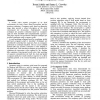Free Online Productivity Tools
i2Speak
i2Symbol
i2OCR
iTex2Img
iWeb2Print
iWeb2Shot
i2Type
iPdf2Split
iPdf2Merge
i2Bopomofo
i2Arabic
i2Style
i2Image
i2PDF
iLatex2Rtf
Sci2ools
ICRA
1994
IEEE
1994
IEEE
A Comparison of Position Estimation Techniques Using Occupancy Grids
A mobile robot requires perception of its local environment for both sensor based locomotion and for position estimation. Occupancy grids, based on ultrasonic range data, provide a robust description of the local environment for locomotion. Unfortunately, current techniques for position estimation based on occupancy grids are both unreliable and computationally expensive. This paper reports on experiments with four techniques for position estimation using occupancy grids. A world modeling technique based on combining global and local occupancy grids is described. Techniques are described for extracting line segments from an occupancy grid based on a Hough transform. The use of an extended Kalman filter for position estimation is then adapted to this framework. Four matching techniques are presented for obtaining the innovation vector required by the Kalman filter equations. Experimental results show that matching of segments extracted from the both the local and global occupancy grids...
| Added | 08 Aug 2010 |
| Updated | 08 Aug 2010 |
| Type | Conference |
| Year | 1994 |
| Where | ICRA |
| Authors | Bernt Schiele, James L. Crowley |
Comments (0)

